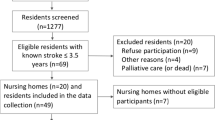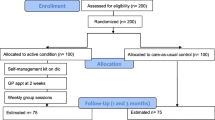Abstract
The needs of community-dwelling stroke patients are often not fully addressed. The Global Stroke Community Advisory Panel had developed the Post Stroke Checklist (PSC) with the aim of standardizing long-term stroke assessment and consequently care of patients. PSC has been validated for UK and Singapore, and an Italian version has been proposed. The aim of this study is to assess the needs of community-dwelling Italian stroke patients using an online version of PSC. Secondary aim is to assess utility of PSC for patients and clinicians. The PSC was administered to a sample of 64 patients with stroke in Italy by general practioners. PSC is a questionnaire formed by 11 questions, each one covering a domain identified as important for patients’ health. After administration of PSC, patient and clinician satisfaction with the PSC was assessed by a specific questionnaire. The PSC identified specific problems for patients related to a worsening from the last examination not evaluated by any specialist. The online PSC highlighted problems related to mood, (in 50% of sample), mobility (53.1%), spasticity (42.2%), and pain (37.5%). Both patients and clinicians provided good results about the utility of online PSC. The PSC was confirmed to be a useful tool for identifying the needs of community-dwelling patients with stroke. Particular attention should be deserved to problems related to mood, mobility, and hence participation to social life, pain, and spasticity. For taking into account these aspects, the online PSC can be a useful portable tool for clinicians.

Similar content being viewed by others
References
Murray CJ, Vos T, Lozano R et al (2012) Disability-adjusted life years (DALYs) for 291 diseases and injuries in 21 regions, 1990–2010: a systematic analysis for the Global Burden of Disease Study 2010. Lancet 380:2197–2223
Go AS, Mozzaffarian D, Roger VL, Benjamin EJ, Berry JD, Blaha MJ et al (2014) Heart disease and stroke statistics—2014 update: a report from the American Heart Association. Circulation 129:e28–e292
Paolucci S, Bragoni M, Coiro P, De Angelis D, Fusco FR, Morelli D et al (2008) Quantification of the probability of reaching mobility independence at discharge from a rehabilitation hospital in nonwalking early ischemic stroke patients: a multivariate study. Cerebrovasc Dis 26(1):16–22
Paolucci S, Iosa M, Toni D, Barbanti P, Bovi P, Cavallini A et al (2016) Prevalence and time course of post-stroke pain: a multicenter prospective hospital-based study. Pain Med 17(5):924–930
Wondergem R, Pisters MF, Wouters EJ, Olthof N, de Bie RA, Visser-Meily JM, Veenhof C (2017) The course of activities in daily living: who is at risk for decline after first ever stroke? Cerebrovasc Dis 43(1–2):1–8
Bernhardt J, Dewey H, Thrift A, Donnan G (2004) Inactive and alone: physical activity within the first 14 days of acute stroke unit care. Stroke 35(4):1005–1009
Prakash V, Shah MA, Hariohm K (2016) Family’s presence associated with increased physical activity in patients with acute stroke: an observational study. Braz J Phys Ther 20(4):306–311
McKevitt C, Fudge N, Redfern J, Sheldenkar A, Crichton S, Wolfe C (2010) A stroke survivor needs survey. 1-1-2010. The Stroke Association, London
Ward AB, Chen C, Norrving B, Gillard P, Walker MF, Blackburn S et al (2014) Evaluation of the Post Stroke Checklist: a pilot study in the United Kingdom and Singapore. Int J Stroke A100(9 Suppl):76–84
Paolucci S, Smania N, Improving the quality of life of stroke survivors: what to do next? (2015) The Italian action for the implementation of a Poststroke Checklist. Eur J Phys Rehabil Med 51(2):233–235
Philp I, Brainin M, Walker MF, Ward AB, Gillard P, Shields AL et al (2013) Development of a poststroke checklist to standardize follow-up care for stroke survivors. J Stroke Cerebrovasc Dis 22:173–180
Jones F (2006) Strategies to enhance chronic disease self-management: how can we apply this to stroke? Disabil Rehabil 28:841–847
Allen KR, Hazelett S, Jarjoura D, Wickstrom GC, Hua K, Weinhardt J et al Effectiveness of a postdischarge care management model for stroke and transient ischemic attack: a randomised trial. J Stroke Cerebrovasc Dis 11:88–98
O'Neill D, Horgan F, Hickey A, Mc Gee H (2008) Long term outcome of stroke: Stroke is a chronic disease with acute events. BMJ 336(7642):461
Fini NA, Holland AE, Keating J, Simek J, Bernhardt J (2017) How physically active are people following stroke? Systematic Review and Quantitative Synthesis Phys Ther. https://doi.org/10.1093/ptj/pzx038
Paolucci S (2008) Epidemiology and treatment of post-stroke depression. Neuropsychiatr Dis Treat 4(1):145–154
Gainotti G, Antonucci G, Marra C et al (2001) Relation between depression after stroke, antidepressant therapy, and functional recovery. J Neurol Neurosurg Psychiatry 71:258–261
Paolucci S, Gandolfo C, Provinciali L, Torta R, Toso V, on behalf of DESTRO Study Group (2006) The Italian multicenter observational study on post-stroke depression (DESTRO). J Neurol 253(5):556–562
Paolucci S (2017) Advances in antidepressants for treating post-stroke depression. Expert Opin Pharmacother. https://doi.org/10.1080/14656566.2017.1334765
Eriksson M, Glader EL, Norrving B, Asplund K (2015) Poststroke suicide attempts and completed suicides: a socioeconomic and nationwide perspective. Neurology 84(17):1732–1738
Picelli A, Baricich A, Cisari C, Paolucci S, Smania N, Sandrini G, on behalf of the Italian Real-Life Survey Group (2017) The Italian real-life post-stroke spasticity survey: unmet needs in the management of spasticity with botulinum toxin type A. Funct Neurol 32(2):89–96
Funding
This study was funded by an unrestricted grant from Allergan.
Author information
Authors and Affiliations
Corresponding author
Ethics declarations
Conflict of interest
The authors declare that they have no conflict of interest.
Electronic supplementary material
ESM 1
(PDF 947 kb).
Rights and permissions
About this article
Cite this article
Iosa, M., Lupo, A., Morone, G. et al. Post Soft Care: Italian implementation of a post-stroke checklist software for primary care and identification of unmet needs in community-dwelling patients. Neurol Sci 39, 135–139 (2018). https://doi.org/10.1007/s10072-017-3140-1
Received:
Accepted:
Published:
Issue Date:
DOI: https://doi.org/10.1007/s10072-017-3140-1




